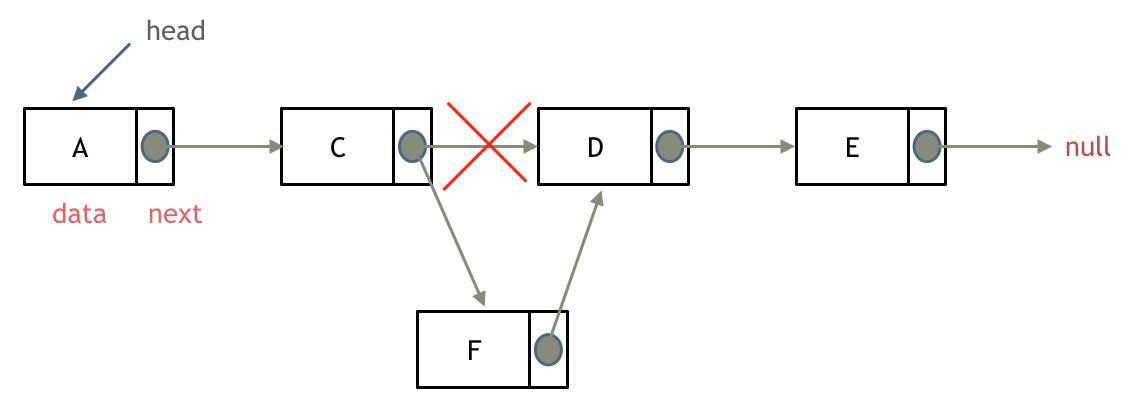部分图和题解来自:https://programmercarl.com/
链表是一种物理存储结构上非连续,非顺序的存储结构,数据元素的逻辑顺序是通过链表中的指针链接次序实现的。
单链表 单链表是一种链式存取的数据结构,链表中的数据是以结点来表示的,每个结点由数据域和指针域构成。
单链表的常见操作
append(value) :向链表尾部添加新节点
removeAt(index):根据索引移除节点,返回数据域
insert(index,value): 向链表的特定位置插入新节点,返回boolean值
get(index): 获取对应索引的节点
indexOf(value): 返回元素在链表中的索引。如果没有该元素返回 -1
update(index,value) : 修改某个位置的元素,返回boolean值
isEmpty():链表是否为空
size():返回链表包含的元素个数。
toString(): 由于链表使用了Node类,就需要重写继承自JavaScript对象默认的toString方法,链表转字符串
单链表的定义 符号说明:
current:暂存当前节点
preNode:暂存当前节点的前一节点
position:当前节点索引
value:节点数据域
next:节点下一节点指针
head:链表头指针
length:链表长度
1 2 3 4 5 6 7 8 9 10 11 12 13 14 15 16 17 18 19 20 21 22 23 24 25 26 27 28 29 30 31 32 33 34 35 36 37 38 39 40 41 42 43 44 45 46 47 48 49 50 51 52 53 54 55 56 57 58 59 60 61 62 63 64 65 66 67 68 69 70 71 72 73 74 75 76 77 78 79 80 81 82 83 84 85 86 87 88 89 90 91 92 93 94 95 96 97 98 99 100 101 102 103 104 105 106 107 108 109 110 111 112 113 114 115 116 117 118 119 120 121 122 123 124 125 126 127 128 129 130 131 132 133 134 135 136 class Node { constructor (val ) { this .value = val; this .next = null ; } } class LinkedList { constructor ( this .head = null ; this .length = 0 ; } append (value ){ let node = new Node (value); let current; if (this .head === null ) { this .head = node; } else { current = this .head ; while (current.next ) { current = current.next ; } current.next = node; } this .length ++; } removeAt (index ) { if (index < 0 || index >= this .length ) return null ; let preNode; let current = this .head ; let position = 0 ; if (index === 0 ) { this .head = current.next ; } else { while (position < index) { preNode = current; current = current.next ; position++; } preNode.next = current.next ; } this .length --; return current.value ; } insert (index,value ){ if (index < 0 || index > this .length ) return false ; let node = new Node (value); let current = this .head ; let preNode; let position = 0 ; if (index === 0 ) { node.next = current; this .head = node; } else { while (position < index) { preNode = current; current = current.next ; position++; } node.next = current; preNode.next = node; } this .length ++; return true ; } getAt (index ) { if (index < 0 || index >= this .length ) { return null ; } let position = 0 ; let current = this .head ; while (position < index) { current = current.next ; position++; } return current.value ; } indexOf (value ) { if (this .length === 0 ) return -1 ; let current = this .head ; let position = 0 ; while (position < this .length ) { if (current.value == value) { return position; } current = current.next ; position++; } return -1 ; } update (index,value ) { if (index < 0 || index >= this .length ) return false ; let position = 0 ; let current = this .head ; while (position < index) { current = current.next ; position++; } current.value = value; return true ; } isEmpty ( return (this .length === 0 ) } size ( return this .length } toString ( let current = this .head ; let str = '' ; while (current) { str += current.value + ((current.next ? ',' : '' )); current = current.next ; } return str; } }
双链表
原文链接:https://blog.csdn.net/qq_44810886/article/details/124540822
双向链表和单向链表的区别是双向链表比单向链表每个节点多一个头指针,这个指针指向前一个节点,每个节点包含包含头指针、数据域、尾指针, 因此从这个节点可以同时访问到它前面和后面的节点。
双链表的常见操作
append(element) :向列表尾部添加一个新的项
insert(position,element): 向列表的特定位置插入一个新的项
get(position): 获取对应位置的元素
indexOf(element): 返回元素在列表中的索引。如果没有该元素返回-1
updata(position,element) : 修改某个位置的元素
removeAt(position):从列表的特定位置移除某一项
remove(element):从列表中移除一项
isEmpty():如果链表中不包含任何元素,返回true,如果链表长度大于0则返回false
size() :返回链表包含的元素个数。与数组的length属性类似
toString(): 由于列表使用了Node类,就需要重写继承自JavaScript对象默认的toString方法,让其只输出元素的值
forwardString():返回正向遍历的节点字符串形式
backwardString():返回反向遍历的节点字符串形式
双链表的函数式定义 1 2 3 4 5 6 7 8 9 10 11 12 13 14 15 16 17 18 19 20 21 22 23 24 25 26 27 28 29 30 31 32 33 34 35 36 37 38 39 40 41 42 43 44 45 46 47 48 49 50 51 52 53 54 55 56 57 58 59 60 61 62 63 64 65 66 67 68 69 70 71 72 73 74 75 76 77 78 79 80 81 82 83 84 85 86 87 88 89 90 91 92 93 94 95 96 97 98 99 100 101 102 103 104 105 106 107 108 109 110 111 112 113 114 115 116 117 118 119 120 121 122 123 124 125 126 127 128 129 130 131 132 133 134 135 136 137 138 139 140 141 142 143 144 145 146 147 148 149 150 151 152 153 154 155 156 157 158 159 160 161 162 163 164 165 166 167 168 169 170 171 172 173 174 175 176 177 178 179 180 181 182 183 184 185 186 187 188 189 190 191 192 193 194 195 196 197 198 199 200 201 202 203 function DoublyLinkedList ( function Node (data ) { this .data = data; this .prev = null ; this .next = null ; } this .head = null ; this .tail = null ; this .length = 0 ; } DoublyLinkedList .prototype append = function (data ) { var newNode = new Node (data) if (this .length == 0 ) { this .head = newNode this .tail = newNode } else { newNode.prev = this .tail ; this .tail .next = newNode; this .tail = newNode; } this .length += 1 } DoublyLinkedList .prototype toString = function ( return this .backwardString () } DoublyLinkedList .prototype forwardString = function ( var current = this .tail ; var resultString = "" while (current) { resultString += current.data + " " ; current = current.prev } return resultString } DoublyLinkedList .prototype backwardString = function ( var current = this .head ; var resultString = "" ; while (current) { resultString += current.data + " " ; current = current.next ; } return resultString } DoublyLinkedList .prototype insert = function (position, data ) { if (position < 0 || position > this .length ) return false var newNode = new Node (data) if (this .length == 0 ) { this .head = newNode this .tail = newNode } else { if (position == 0 ) { this .head .prev = newNode; newNode.next = this .head ; this .head = newNode; } else if (position == this .length ) { newNode.prev = this .tail ; this .tail .next = newNode; this .tail = newNode; } else { var current = this .head ; var index = 0 ; while (index++ < position) { current = current.next ; } newNode.next = current; newNode.prev = current.prev ; current.prev .next = newNode; current.prev = newNode; } } this .length += 1 ; return true } DoublyLinkedList .prototype get = function (position ) { if (position < 0 || position >= this .length ) return null var index = 0 ; var current = this .head ; while (index++ < position) { current = current.next ; } return current.data } DoublyLinkedList .prototype indexOf = function (element ) { var current = this .head ; var index = 0 ; while (current) { if (current.data == element) { return index } else { current = current.next index += 1 } return -1 } } DoublyLinkedList .prototype updata = function (position, newData ) { if (position < 0 || position >= this .length ) return false var current = this .head ; var index = 0 ; while (index++ < position) { current = current.next } current.data = newData return true } DoublyLinkedList .prototype removeAt = function (position ) { if (position < 0 || position >= this .length ) return null var current = this .head ; if (this .length == 1 ) { this .head = null this .tail = null } else { if (position == 0 ) { this .head .next .prev = null ; this .head = this .head .next } else if (position == this .length - 1 ) { current = this .tail this .tail .prev .next = null ; this .tail = this .tail .prev } else { var index = 0 ; while (index++ < position) { current = current.next ; } current.prev .next = current.next ; current.next .prev = current.prev ; } } this .length -= 1 ; return current.data } DoublyLinkedList .prototype remove = function (data ) { var index = this .indexOf (data) return this .removeAt (index) } DoublyLinkedList .prototype isEmpty = function ( return this .length == 0 } DoublyLinkedList .prototype size = function ( return this .length } DoublyLinkedList .prototype getHead = function ( return this .head .data } DoublyLinkedList .prototype getTail = function ( return this .tail .data }





